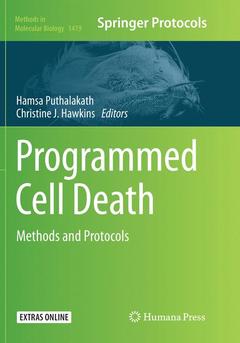Description
Programmed Cell Death, 1st ed. 2016
Methods and Protocols
Methods in Molecular Biology Series, Vol. 1419
Coordinators: Puthalakath Hamsa, Hawkins Christine J.
Language: English
Subject for Programmed Cell Death:
Keywords
delineating the molecular mechanisms; Drosophila; metazoan apoptosis process; apoptosis detection techniques; autophagic cell death processes; caspase activity initiation at single cell level; peptide-based techniques for detecting caspases; Bcl-2 family protein dynamics; protein-protein interactions; genome editing; apoptosis
Support: Print on demand
291 p. · 17.8x25.4 cm · Hardback
Description
/li>Contents
/li>Comment
/li>
This volume contains protocols specifically designed for studying programmed cell death, and also discusses recent advances in techniques that span broader areas of biology that have been recently used or that have potential to be incorporated into cell death research. The protocols are mostly described in the context of mammalian systems, but also cover other systems such as plants, Drosophila, and yeast. Programmed Cell Death: Methods and Protocols is comprised of 20 chapters: Chapters 1-5 describe apoptosis detection techniques; Chapter 6-9 describe methods for studying apoptosis associated with various pathologies in different organs including the lymphoid compartment, intestinal epithelium, granulocytes, and cardiomyocytes; Chapter 11-13 cover protocols and techniques for studying apoptosis in non-mammalian systems; Chapters 14-16 cover biochemical and biophysical methods for studying Bcl-2 family protein dynamics and protein-protein interactions during apoptosis; and the last four chapters explore protocols that are useful not only in apoptosis research but in wider areas of biological research, such as genome editing, inducible transgenes, and proteomics. Written in the highly successful Methods in Molecular Biologyaeries format, chapters include introductions to their respective topics, lists of the necessary material and reagents, step-by-step, readily reproducible laboratory protocol, and tips on troubleshooting and avoiding known pitfalls.
Thorough and cutting-edge, Programmed Cell Death: Methods and Protocols is a comprehensive and valuable resource for researchers, ranging from beginner to expert, in their studies on programmed cell death.
1. Detection of Apoptotic Versus Autophagic Cell Death by Flow Cytometry
Valentina Sica, M. Chiara Maiuri, Guido Kroemer, and Lorenzo Galluzzi
2. In Vivo Apoptosis Imaging Using Site-Specifically 68Ga-Labeled Annexin V
Matthias Bauwens
3. Detection of Active Caspases during Apoptosis Using Fluorescent Activity-Based Probes
Laura E. Edgington-Mitchell and Matthew Bogyo
4. Detection of Initiator Caspase Induced Proximity in Single Cells by Caspase Bimolecular Fluorescence Complementation
Melissa J. Parsons, Sara R. Fassio, and Lisa Bouchier-Hayes
5. In Vitro Use of Peptide Based Substrates and Inhibitors of Apoptotic Caspases
Gavin P. McStay
6. Experimental In Vivo Sepsis Models to Monitor Immune Cell Apoptosis and Survival in Laboratory Mice
Marcel Doerflinger, Jason Glab, and Hamsa Puthalakath
7. Analysis of Cell Death Induction in Intestinal Organoids In Vitro
Thomas Grabinger, Eugenia Delgado, and Thomas Brunner
8. In Vitro Differentiation of Mouse Granulocytes
Ramona Reinhart, Simone Wicki, and Thomas Kaufmann
9. Hydrodynamic Injection as a Method of Gene Delivery in Mice: A Model of Chronic Hepatitis B Virus Infection
Simon P. Preston, Marc Pellegrini, and Gregor Ebert
10. Isolation of Cardiomyocytes and Cardiofibroblasts for Ex-Vivo Analysis
George W. Mbogo, Christina Nedeva, and Hamsa Puthalakath
11. Detection of Cell Death in Drosophila Tissues
Deepika Vasudevan and Hyung Don Ryoo
12. Methods to Study Plant Programmed Cell Death
Joanna Kacprzyk, Adrian N. Dauphinee, Patrick Gallois, Arunika HLAN Gunawardena, and Paul F. McCabe
13. Modeling Metazoan Apoptotic Pathways in Yeast
David T. Bloomer, Tanja Kitevska, Ingo L. Brand, Anissa M. Jabbour, Hang Nguyen, and Christine J. Hawkins
14. Characterizing Bcl-2 Family Protein Conformation and Oligomerization Using Cross-Linking and Antibody Gel-Shift in Conjunction with Native PAGE
Grant Dewson
15. Using Förster-Resonance Energy Transfer to Measure Protein Interactions between Bcl-2 Family Proteins on Mitochondrial Membranes
Justin P. Pogmore, James M. Pemberton, Xiaoke Chi, and David W. Andrews
16. Preparing Samples for Crystallization of Bcl-2 Family Complexes
Marc Kvansakul and Peter E. Czabotar
17. Screening Strategies for TALEN Mediated Gene Disruption
Boris Reljić and David A. Stroud
18. Using CRISPR/Cas9 Technology for Manipulating Cell Death Regulators
Andrew J. Kueh and Marco J. Herold
19. Lentiviral Vectors to Analyze Cell Death Regulators
Ueli Nachbur and Gabriela Brumatti
20. Proteomic Profiling of Cell Death: Stable Isotope Labeling and Mass Spectrometry Analysis
Andrew I. Webb
Includes cutting-edge methods and protocols
Provides step-by-step detail essential for reproducible results
Contains key notes and implementation advice from the experts
Includes supplementary material: sn.pub/extras




